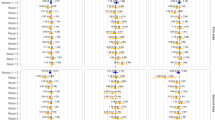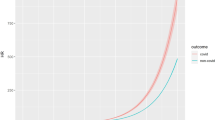Abstract
Background/Objectives:
Anaemia accounts for a significant proportion of pre- and post-partum morbidity and mortality in low-income countries with sequelae, including an increased risk of infection. Factors contributing to anaemia need to be addressed through the introduction of evidence-based measures to control and prevent the disease. We aimed to determine the prevalence of anaemia in women of child-bearing age in the Democratic Republic of Congo (DRC) and investigate the associated individual, household and community level factors.
Subjects/Methods:
Cross sectional representative population data from the 2013–2014 DRC Demographic and Health Survey (DHS) was used. The primary outcome was anaemia in women, stratified according to pregnancy in those of child-bearing age. A haemoglobin level of below 11 g/dl for pregnant women and 12 g/dl for non-pregnant women was used as the indicator of anaemia. Using a three-level random intercept model this study explored risk factors at individual, household and community levels and quantified the observed and unobserved variations between households and communities.
Results:
Thirty-eight percent of women in the DRC are anaemic. Anaemia is significantly higher in younger, pregnant and underweight women, as well as those with comorbidities, including HIV and malaria who are living in the capital city Kinshasa. Anaemia varies within and between households and communities in the DRC.
Conclusions:
Integrated approaches to reduce anaemia in settings with high malaria and HIV prevalence such as the DRC should target households.
This is a preview of subscription content, access via your institution
Access options
Subscribe to this journal
Receive 12 print issues and online access
$259.00 per year
only $21.58 per issue
Buy this article
- Purchase on Springer Link
- Instant access to full article PDF
Prices may be subject to local taxes which are calculated during checkout

Similar content being viewed by others
References
Wirth JP, Woodruff BA, Engle-Stone R, Namaste SM, Temple VJ, Petry N, et al. Predictors of anemia in women of reproductive age: Biomarkers Reflecting Inflammation and Nutritional Determinants of Anemia (BRINDA) project. Am J Clin Nutr. 2017;106(Suppl 1):416S–27S.
Ullrich C, Wu A, Armsby C, Rieber S, Wingerter S, Brugnara C, et al. Screening healthy infants for iron deficiency using reticulocyte hemoglobin content. JAMA. 2005;294:924–30.
Kandala NI. Socio-demographic determinants of anaemia and nutritional status in the Democratic Republic of Congo, Uganda and Malawi (Unpublished Doctoral thesis). University of Southampton, Southampton, UK) https://eprints.soton.ac.uk/354347/. 2013.
Stevens GA, Finucane MM, De-Regil LM, Paciorek CJ, Flaxman SR, Branca F, et al. Global, regional, and national trends in haemoglobin concentration and prevalence of total and severe anaemia in children and pregnant and non-pregnant women for 1995-2011: a systematic analysis of population-representative data. Lancet Glob Health. 2013;1:e16–25.
Win H, Ko M. Geographical disparities and determinants of anaemia among women of reproductive age in Myanmar: analysis of the 2015–2016 Myanmar Demographic and Health Survey. WHO South-East Asia J Public Health. 2018;7:107–13.
Kibret KT, Chojenta C, D’Arcy E, Loxton D. Spatial distribution and determinant factors of anaemia among women of reproductive age in Ethiopia: a multilevel and spatial analysis. BMJ Open. 2019;9:e027276.
Benoist de B, McLean E, Egli I, Cogswell M. Worldwide prevalence of anaemia 1993–2005: WHO Global Database on Anaemia, WHO, ed. Geneva: WHO; 2008.
van den Broek N. Anaemia and micronutrient deficiencies: Reducing maternal death and disability during pregnancy. Br Med Bull. 2003;67:149–60.
Petry N, Olofin I, Hurrell RF, Boy E, Wirth JP, Moursi M, et al. The proportion of anemia associated with iron deficiency in low, medium, and high human development index countries: a systematic analysis of national surveys. Nutrients, 2016;8:pii:E693.
Camaschella C. Iron-deficiency anemia. New Engl J Med. 2015;372:1832–43.
Lanjouw JO, Lanjouw P. The rural non-farm sector: issues and evidence from developing countries. Agric Econ. 2001;26:1–23.
Olusanya BO, Luxon LM, Wirz SL. Benefits and challenges of newborn hearing screening for developing countries. Int J Pediatr Otorhinolaryngol. 2004;68:287–305.
Casey GJ, Montresor A, Cavalli-Sforza LT, Thu H, Phu LB, Tinh TT, et al. Elimination of iron deficiency anemia and soil transmitted Helminth infection: evidence from a fifty-four month iron-folic acid and de-worming program. PLoS Neglected Tropical Dis. 2013;7:e2146.
Foote EM, Sullivan KM, Ruth LJ, Oremo J, Sadumah I, Williams TN, et al. Determinants of anemia among preschool children in rural, western Kenya. Am J tropical Med Hyg. 2013;88:757–64.
Lakew Y, Biadgilign S, Haile D. Anaemia prevalence and associated factors among lactating mothers in Ethiopia: evidence from the 2005 and 2011 demographic and health surveys. BMJ Open. 2015;5:e006001–6001.
Spottiswoode N, Duffy PE, Drakesmith H. Iron, anemia and hepcidin in malaria. Front Pharm. 2014;5:125.
Engstrom EM, de Castro IRR, Margareth P, Cardoso LO, Monteiro CA. Effectiveness of Daily and Weekly Iron Supplementation in the Prevention of Anemia in Infants. Ann Nutr Metab. 2009;55:439–9.
WHO. World Malaria Report 2018, WHO ed. Geneva: WHO; 2018.
Cox FEG. History of human parasitology. Clin Microbiol Rev. 2002;15:595.
Smith JL, Brooker S. Impact of hookworm infection and deworming on anaemia in non-pregnant populations: a systematic review. Tropical Med Int Health: TM IH. 2010;15:776–95.
Pasricha S-R, Caruana SR, Phuc TQ, Casey GJ, Jolley D, Kingsland S, et al. Anemia, iron deficiency, meat consumption, and hookworm infection in women of reproductive age in northwest Vietnam. Am J tropical Med Hyg. 2008;78:375–81.
Dhurve SA, Dhurve AS. Bone marrow abnormalities in HIV disease. Mediterranean J Hematol Infect Dis. 2013;5:e2013033–33.
van den Berg K, Murphy EL, Pretorius L, Louw VJ. The impact of HIV-associated anaemia on the incidence of red blood cell transfusion: implications for blood services in HIV-endemic countries. Transfus Apheresis Sci: Off J World Apheresis Assoc: Off J Eur Soc Haemapheresis. 2014;51:10–18.
van Ansem WJ, Schrijvers CT, Rodenburg G, van de Mheen D. Maternal educational level and children’s healthy eating behaviour: role of the home food environment (cross-sectional results from the INPACT study). Int J Behav Nutr Phys Act. 2014;11:113–113.
DHS. Congo Democratic Republic DHS, 2013-14—Final Report 2014, Demographic Health Surveys. https://dhsprogram.com/Publications/Publications-by-Country.cfm.
Gibson RS. Principles of nutritional assessment. Oxford, United Kingdom: Oxford University Press; 2005.
Lu MC. We can do better: improving perinatal health in America. J Women’s Health. 2010;19:569–74.
Kazembe LN, Appleton CC, Kleinschmidt I. Choice of treatment for fever at household level in Malawi: examining spatial patterns. Malaria J. 2007;6:6–40.
Aarts E, Verhage M, Veenvliet JV, Dolan CV, van der Sluis S. A solution to dependency: using multilevel analysis to accommodate nested data. Nat Neurosci. 2014;17:491–6.
Pfeffermann D, Skinner CJ, Holmes DJ, Goldstein H, Rasbash J. Weighting for unequal selection probabilities in multilevel models. J R Stat Soc Ser B-Stat Methodol. 1998;60:23–40.
Chambers RL, Sugden RA, Longford N, Little RJ, Binder DA, Dorfman AH, et al. Weighting for unequal selection probabilities in multilevel models—Discussion on the papers by Firth and Bennett and Pfeffermann et al. J R Stat Soc Ser B-Stat Methodol. 1998;60:41–56.
Rabe-Hesketh S, Skrondal A. Multilevel modelling of complex survey data. J R Stat Soc Ser a-Stat Soc. 2006;169:805–27.
Ministère du PC, Macro I. République Démocratique du Congo Enquête Démographique et de Santé 2007. Ministère du Plan/Congo and Macro International: Calverton, MD, USA; 2008.
FAO. Obesity in developing countries, FAO ed. FAO: Rome; 2000.
Abalo EM, Agyemang S, Atio S, Ofosu-Bosompem D, Peprah P, Ampomah-Sarpong R. Environmental sanitation unleashed: effectiveness and challenges of the National Sanitation Day as a community sanitation participatory approach in Aboabo, Ghana. Cogent Environ Sci. 2017;3:1405888.
FFI. Food Fortification Initiative :15 years of partnering for success. Food Fortification Initiative: USA; 2018.
White NJ. Anaemia and malaria. Malar J. 2018;17:371.
Kalenga MK, Nyembo MK, Nshimba M, Foidart JM. [Anemia and associated factors (Malaria and intestinal Helminthiasis) in Lubumbashi]. Sté Publique. 2003;15:413–21.
Bedwell RM, Spielvogel H, Bellido D, Vitzthum VJ. Factors Influencing the use of biomedical health care by rural Bolivian anemic women: structural barriers, reproductive status, gender roles, and concepts of anemia. PLoS ONE. 2017;12:e0170475–75.
Ugwuja EI, Ogbonnaya LU, Obuna AJ, Awelegbe F, Uro-Chukwu H. Anaemia in relation to body mass index (BMI) and socio-demographic characteristics in adult Nigerians in Ebonyi state. J Clin Diag Res. 2015; 9: LC04–7.
Yasuda JL, Rufo PA. Protein-losing enteropathy in the setting of severe iron deficiency anemia. J Investig Med High Impact Case Rep. 2018;6:2324709618760078–78.
Brockerhoff M. Urban growth in developing countries: a review of projections and predictions. Popul Dev Rev. 1999;25:757–78.
Seto KC, Güneralp B, Hutyra LR. Global forecasts of urban expansion to 2030 and direct impacts on biodiversity and carbon pools. Proc Natl Acad Sci. 2012;109:16083.
Buttenheim AM. The sanitation environment in urban slums: implications for child health. Popul Environ. 2008;30:26–47.
Bird K, Shepherd A. Livelihoods and chronic poverty in semi-arid Zimbabwe. World Dev. 2003;31:591–610.
Roberts L. Kinshasa little relief for eastern Democratic Republic of Congo. Lancet. 2001;357:1421.
Jack F, Alexis DA, Celeste S. Nutrition technical brief: a rapid initial assessment of the distribution and consumption of iron–folic acid tablets through antenatal care in the Democratic Republic of Congo. USAID ed. USAID: Arlington; 2014.
Belitz HD, Werner G, Peter S. Food chemistry. 4 ed. Springer-Verlag: Berlin Heidelberg; 2009.
Feinstein L, Dimomfu BL, Mupenda B, Duvall S, Chalachala JL, Edmonds A, et al. Antenatal and delivery services in Kinshasa, Democratic Republic of Congo: care-seeking and experiences reported by women in a household-based survey. Tropical Med Int Health. 2013;18:1211–21.
Ivoke N, Ikpor N, Ivoke O, Ekeh F, Ezenwaji N, Odo G, et al. Geophagy as risk behaviour for gastrointestinal nematode infections among pregnant women attending antenatal clinics in a humid tropical zone of Nigeria. Afr Health Sci. 2017;17:24–31.
Short SE, Mollborn S. Social determinants and health behaviors: conceptual frames and empirical advances. Curr Opin Psychol. 2015;5:78–84.
Acknowledgements
We are grateful to the USAID, DHS Programme for granting us access to the Democratic Republic of Congo 2013–2014 Demographic Health Surveys.
Author contributions
NK formulated the research question and designed the study. NK performed statistical analysis. NK, SP, NM, AC and GK wrote the paper. NK, SP, NM, GK and AC had primary responsibility for final content. All authors have read and approved the final manuscript.
Author information
Authors and Affiliations
Corresponding author
Ethics declarations
Conflict of interest
The authors declare that they have no conflict of interest.
Additional information
Publisher’s note Springer Nature remains neutral with regard to jurisdictional claims in published maps and institutional affiliations.
Rights and permissions
About this article
Cite this article
Kandala, N.I., Pallikadavath, S., Amos Channon, A. et al. A multilevel approach to correlates of anaemia in women in the Democratic Republic of Congo: findings from a nationally representative survey. Eur J Clin Nutr 74, 720–731 (2020). https://doi.org/10.1038/s41430-019-0524-8
Received:
Revised:
Accepted:
Published:
Issue Date:
DOI: https://doi.org/10.1038/s41430-019-0524-8
This article is cited by
-
Determinants of anemia among women of childbearing age: analysis of the 2018 Mali demographic and health survey
Archives of Public Health (2023)



